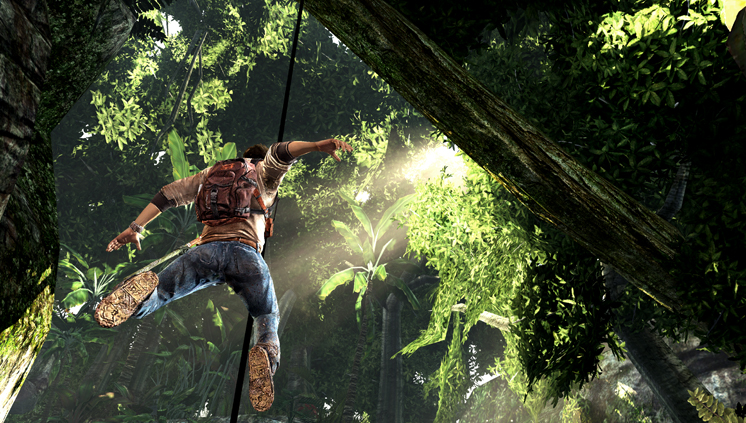Drake’s on a plane… or anywhere else you wanna play.
Gamers consistently complain about titles with annual release cycles, but Uncharted: Golden Abyss takes it to the next level and lands just three months after Drake’s Deception, without really bringing anything new. Three months might seem like quick turn-around, but I just don’t care. It’s more Uncharted, right now.
With the memory of Drake’s Deception fresh in my mind, Sony Bend’s job at adapting Naughty Dog’s series was never going to be easy, but you really can’t tell that the game is from another developer, except that the game doesn’t innovate or expand on the series.
Visually, Golden Abyss obviously can’t hold up to its console counterparts, but compared to other Vita games or other handheld titles, GA is gorgeous. Set pieces look impressive but aren’t as ambitious as previous titles. You may still jump off a collapsing building onto a more stable one—just don’t expect the same “Oh my god, did that just happen?” reaction.
Close-up visuals on hair and faces looks decent, but the backdrop is what really makes the most of the OLED screen. As birds flutter across the setting sun, you’d be forgiven for stopping and staring at the views and ignoring the bullets whizzing around you.
As for audio, if you’re wearing headphones, it’s hard to find anything to complain about. Music is clearly reminiscent of other Uncharted OSTs and Nolan North’s sexy voice once again conveys delicate emotions that can only be expressioned through motion capture.

Through these mocapped cut-scenes and conversations with Drake as he traverses across caves, rainforests, and rivers, you’ll learn about this game’s big enemy—Guerro, a disgraced ex-general seeking treasure and power—and meet new friends like the cute-but-not-as-hot-as-Chloe-or-Elena companion Marisa Chase.
Considering it’s a game, GA gets plus points for having a plot that is actually coherent, has a beginning, a middle, and an end. John Garvin should also get credit for capturing the essence of the series-staple characters, who don’t seem to have changed much. But really, it’s not exactly the most original of plots or one that would win any accolades in another medium. Uncharted is often compared to Indiana Jones, but the plot here would make for a boring and uninspiring movie, lacking serious depth or intrigue.

The game is still a solid ten hours—something that sadly most console games fail to achieve—and you’ll enjoy every moment of it if you’re an Uncharted fan. Climb across crumbling ravines, stare up at an ancient Incan statue, marvel at its age, and read about its history… and then blow it up. Blowing up priceless monuments as you strive to find smaller and less valuable-looking artifacts is a staple tradition of the series and something that Bend has used to good effect.
The usual cover-based shooting is a central part of the game, only this time with a few Vita-specific treats. For example, dragging your finger across the back of the Vita can be used to zoom in and out with a sniper rifle. You can also move your Vita, which will in turn, move the gun reticule, allowing for precise aiming. At first I was against the idea of Sixaxis-based aiming, but after a while I grew used to it and began to like it. Luckily, it is entirely optional.

What isn’t optional, however, is the occasional touch-based obstacle. After I’d just snapped the neck of a guard, headshotted three more, and casually quipped while blowing up a truck full of innocent mercenaries, I was confronted with a draped cloth. The horror. To defeat this boss enemy, you’ll have to swipe the screen a couple of times to chop it down with a machete—so the cloth isn’t a tough adversary, just an irritating one. The addition of the machete, which was added simply to give the game some touch elements, is by no means a game-breaking feature, but it is certainly a game-slowing one.
It’s a shame too, because the ability to draw a route with your finger when climbing is a fantastic feature that lets you direct Nate quickly as he automatically follows the mapped pathway. That alone makes the touch screen worth it, so the game shouldn’t have to push gimmicky obstacles.
But really, all the game’s complaints won’t detract from the simple fact that this is Uncharted on a handheld. It’s just slightly diminished. Golden Abyss is more like Drake’s Fortune than it is Deception—it doesn’t span that many environments, has smaller set pieces, and lacks online multiplayer. Regardless, where Drake’s Fortune proved what the PS3 was capable of back in ’07, Golden Abyss proves what the Vita is capable of—and it does that at launch.
-
Uncharted... in the palm of your hands
-
On par with the console experience...
-
...but doesn't offer much more
-
The best Vita game at launch
-
Too touch-focused







